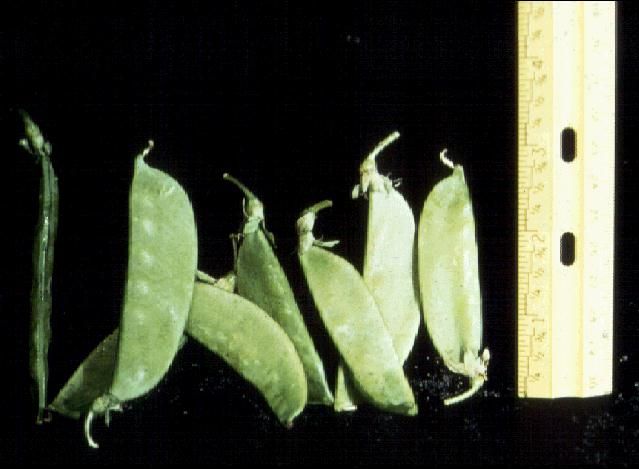Pea, Snap—Pisum sativum L. (Macrocarpon group)1
Snap peas are a group of edible-podded peas differing from snow peas in their round instead of flat pod shapes. An edible, podded pea is similar to an ordinary garden (English) pea. The pod of the English pea is lined on the inside with a thin, hard, tough membrane that contracts as the pod ripens and dries, causing the pod to open, twist, and expel its seeds. In contrast, pods of the edible, podded pea, including snap peas, do not have the membrane and do not open when ripe.

Credit: Blue Goose, Inc.

Credit: James M. Stephens, UF/IFAS
Description
Pods are soft, tender, and edible. Snap peas are so crisp, sweet, and succulent that they may be snapped into pieces and mixed into salads or eaten whole as an appetizer. Like snow peas, they also may be stir-fried or steamed.
Snap peas have a distinctive appearance and flavor. The pods are round and reach a length of 2½ to 3 inches at maturity. Pod walls are rather thin in comparison with snow peas. Mature pods require stringing, which is the removal of a membranous thread-like string running the length of the pod on top and bottom. This is similar to the string in the pods of early bean varieties that gave them the name string beans. Occasionally there will be overgrown, fibrous pods that may be shelled and combined with other more-tender edible pods.
Culture
There are several varieties of snap peas, including 'Sugar Rae,' 'Sugar Bon,' 'Sugar Ann,' and 'Sugar Snap.' Probably the most notable of these is 'Sugar Snap' because of winning an All-America Gold Award in 1979. 'Sugar Snap' has a vining plant character. Plants may reach a height of 6 feet or more, but usually are about 4 feet high. A trellis or other support system is required. To grow snap peas, follow the same cultural procedures as for pole beans.
Snap pea is a cool season vegetable, best grown in Florida from plantings in September through March. It has been reported to recover from frost and from cold down to 20°F. Unlike English peas, however, snap peas have a wider adaptation and tolerate higher temperatures than garden peas. Florida gardeners planting peas in March generally observe some drop-off in pod production because of higher temperatures of late spring. 'Sugar Snap' matures in 70–75 days following seeding.
Use
Gardeners who are aware of the nutritional aspects of vegetables will be delighted with snap peas. The peas are nutritious and filling but are not as high in total carbohydrates and fats as green shelled English peas. The crunchy pods contribute mostly water and vitamins to the diet.
Overcooking the pods will make them come apart. They should be lightly steamed or quickly fried in oil to retain a touch of crispness. Snap peas may be frozen but should not be canned since high temperatures destroy the structure of the pods.
Snap peas may be used in a salad, omelet, soup, or stew. By themselves, they can be eaten as a substitute for french fries, stuffed, or batterfried.


